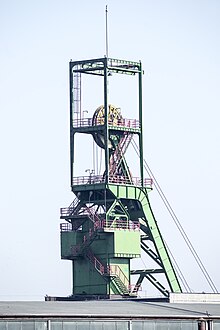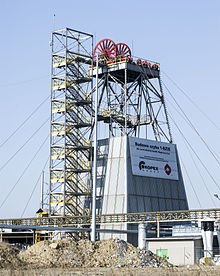Kopalnia Węgla Kamiennego Borynia-Zofiówka-Jastrzębie
The Borynia-Zofiówka-Jastrzębie Mine ( Kopalnia Węgla Kamiennego Borynia-Zofiówka-Jastrzębie ) is an active hard coal mine of Jastrzębska Spółka Węglowa SA in the northeast and west of Jastrzębie-Zdrój , Poland.
Because numerous deposits of fat coal were found in the triangle of cities Rybnik - Jastrzemb - Loslau and, as a result of detailed explorations, seam deposits of 1 billion t of coking coal (as of 1958) were found, the Polish state economy planned the construction of numerous mines in this area. The first of them was Mszana (under construction from 1952), later called KWK 1. Maja , the last one in Warszowice , the construction of which had started in the late 1980s. Many of these new mines had a very short lifespan; so was Warszowice shut down again after 20 years. The two mines in this area, Borynia and Zofiówka , are likely to have a longer lifespan, while Jas-Mos will be closed in large parts.
history
The historical presentation deals with the mines belonging to the new association separately.
CHP Borynia
In February 1959, at a conference in Gliwice, the decision was made to build a new mine called Borynia ( location ) north of Jastrzębie. But it took 12 years before the mine opened on December 4, 1971 and production could begin. Initially part of the "Rybnik Coal Industry Association", in 1993 it became part of the mining division of Jastrzębska Spółka Węglowa SA (JSW). Since 1972, 80 million tons of hard coal have been mined in the area of the plant and sections of 773 km in length have been driven.
In view of the fact that the Borynia deposits will be exhausted in the next few years , a search was made for minable seams east of the previous mining area and these were found in Zory-Warszowice. This seems strange because for the short period from the end of the 1980s to the fall of communism in Warszowice there was a mine with three shafts, a laundry and a chew . When driving several stretches, however, it became apparent that the coal deposits there were too small. Therefore, the facility in Warszowice was demolished in 2000.
In addition to the three shafts on the central system (ski transport; cable car; material transport), the mine also has two additional weather shafts , shafts IV and V. One of them has an access system. The coal mining takes place on the 713-m, 838-m and 950-m-soles instead.
CHP Zofiówka
The mine ( Lage ) was put into operation on December 4, 1969. Bearing the name Manifest Lipcowy from 1974 to 1990 , it was operated by the Rybnik Department of the “ Coal Industry Associations” until 1982, and since 1993 by JSW SA.
The mine supports on soles in 705 m, 830 m and 900 m depth. In 2007, the sinking of the "1 Bzie" shaft began to a depth of 1110 m. The mine thus has five shafts, four on the central system and the outer shaft "1 Bzie".
On May 5, 2018, an earthquake with a magnitude of 3.4 occurred at a depth of 900 m. There were 11 miners in the pit. 4 of them drove out, 2 were rescued by rescue workers, 2 died, 3 are still missing on May 7th.
CHP Jas-Mos
Jas-Mos ( Lage ) is a mine in Jastrzębie-Zdroj, built between 1955 and 1962, which was initially run independently under the name Jastrzębie . Cooperation with KWK Moszczenica took place at an early stage, which resulted in a merger on January 1, 1995 under the name Jas-Mos .
Since the closure of Moszczenica in 1999, the mine has been extracting 6,700 tonnes per day from the two levels at 400 m and 600 m depth on an area of 32.5 km². The colliery has five shafts, a conveyor shaft, two shafts for cable travel and material transport, as well as two weather shafts. In 2013, the Borynia-Zofiówka-Jastrzębie composite mine was formed .
CHP Jastrzębie
The Jas-Mos mine initially bore this name. It has appeared again in the name of the new composite mine since 2013.
CHP Moszczenica
From 1954 there are plans to build one or more mines in the south and west of Jastrzębie, which initially resulted in the establishment of a development company called Jastrzębie-im-Bau . From 1962 to 1965, the name was to Jastrzębie-Moszczenica-in construction expanded, which together with the opening of the mine Moszczenica ( position indicating) in 1962 that early two mines were planned in this area.
In 1978 the 400 m level was driven with the aim of achieving a daily production of 7,000 t. At that time, the mine had four shafts, the “Były” shaft with a concrete tower and skip conveyor and two weather shafts.
In 1994 the merger with Jastrzębie took place under the name Jas-Mos and in 1999 Moszczenica was shut down .
In 2001, the demolition of the daytime facilities began, with the exception of a concrete tower over “Były” and an electric power station.
Jastrzębie Department
Another restructuring of the Jas-Mos mine took place on October 1, 2016 . A larger part was given to the state-owned "Spółka Restructureyzacji Kopalń" with the aim of re-using this area by 2025.
The part remaining with JSW is again named Jastrzębie , the 1,600 employees have been taken over by the SRK. The mining of the remaining hard coal fields is to be done from Zofióka in the future .
present
On January 1, 2013, the Borynia-Zofiówka-Jastrzębie composite mine was founded by a decision of the Board of Directors of Jastrzębska Spółka Węglowa SA . It consists of the three individual systems Borynia , Zofiówka and Jas Mos . According to the operating company, the organizational amalgamation of the mines is intended to generate synergies
- a better use of investment and production resources
- greater opportunities to share machines, equipment and materials
- the possibility of coordination in employment policy
- the shared use of organizational structures
enable.
In addition, all three mines have identical concrete headframes ( skips for lifting the coal), double-headed frames ( rope travel and material transport) and smaller headframes for material transport. The integration of the transport systems for the transport of the coal from the individual pits to the others should make it possible to improve the quality of the coal and, in the joint processing, to deliver products that are easier to sell. Here is an overview of the individual facilities of the composite mine (as of early 2016):
| Colliery | Net funding (t / d) | Authorized rights in km² | Operating reserves in million t | Production period without strategic investments |
|---|---|---|---|---|
| Borynia | 9,600 t | 17.4 | 34.0 | 2030 |
| Zofiówka | 10,300 t | 16.4 | 87.0 | 2021 |
| Jas-mos | 11,100 t | 32.5 | 34.1 | 2022 |
The latest development of the Jas-Mos / Jastrzębie department (see above) shows that such plans often only last for a short time in the face of the structural problems of the Polish coal industry .
Funding figures
- Borynia 1979: 2.90 million tons
- Zofiówka 1970: 316,106 t; 1979: 3.42 million t
- Jastrzębie / Jas-Mos 1970: 2.17 million t; 1979: 3.30 million t
- Moszczenica 1970: 2.30 million t; 1979: 3.42 million t
Remarks
- ^ Kurt König: The hard coal mining in Upper Silesia from 1945–1955. Scientific contributions to the history and regional studies of Eastern Central Europe. Published by the Johann Gottfried Herder Institute. Marburg 1958, p. 61.
- ↑ Two dead and three missing after a mine accident in Poland orf.at, May 7, 2018, accessed May 7, 2018.
- ↑ see http://www.rp.pl/Wegiel/310019973-JSW-podpisal-umowe-z-SRK-Jas-Mos-to-osma-kopalnia-w-SRK.html (accessed on April 13, 2017)
- ↑ a b Borynia-Zofiówka-Jastrzębie (Polish) accessed on February 14, 2016.
literature
- Jerzy Jaros: Słownik historyczny kopalń węgla na ziemiach polskich . Katowice 1984.
- Kurt König: The coal mining in Upper Silesia from 1945–1955 . Scientific contributions to the history and regional studies of Eastern Central Europe. Published by the Johann Gottfried Herder Institute. Marburg 1958.
Web links
- JSW SA provides numerous figures and details on the three described here in Polish on its website https://www.jsw.pl/o-nas/zaklady/borynia-zofiowka-jastrzebie/ (accessed on February 8, 2016) Mines.





